-

06 // Pressetexte # 01 Samui, 2008
32. Bremer Förderpreis für Bildende Kunst 2008Städtische Galerie im Buntentor / BremenBegründung der Jury zur Preisvergabe (02.02.09):Preechaya Siripanichs Arbeit "Samui" (2008) überzeugt durch Kombinationen aus skulpturalen Elementen im installativen Gesamtzusammenhang. Der Künstler verknüpft Situationen von Traditionen mit bewusst ironisch-melancholischen Zügen. Erschafft modellhafte Situationen von kompositorischer Dichte, verliert hierbei aber das einfache Schlichte und Rudimentäre nicht aus den Augen. Seine Werke behandeln Aspekte von Sehnsucht, Heimat, Konsum, urbanen Kontexten und damit verbundenen Werten, thematisieren jedoch immer die Widersprüche des alltäglichen Lebens und verwandeln diese in abstrahierte, poetische Zusammenhänge.
Die Jury:
Leonie Baumann, Neue Gesellschaft für Bildende Kunst (NGBK), Berlin
Dr.Brigitte Franzen, Ludwig Forum für Internationale Kunst, Aachen
Dr. Gregor Jansen, ZKM / Museum für Neue Kunst, Karlsruhe
René Zechlin, Kunstverein Hannover
-

01 // Arbeiten 2006 # 01 Das Zelt, tiefgefrorene Tüte, Pflaster, Waschpulver, 130 x 200 x 90 cm
-

01 // Arbeiten 2006 # 05 BrePark, Pappe, Holzplatte, Metall, Fischdosen, 140 x 125 x 50 cm
-

01 // Arbeiten 2006 # 06 BrePark (Detail)
-

01 // Arbeiten 2006 # 07 o.T., Pappe, Holzplatte, Metall, Fischdosen, 140 x 125 x 50 cm
-
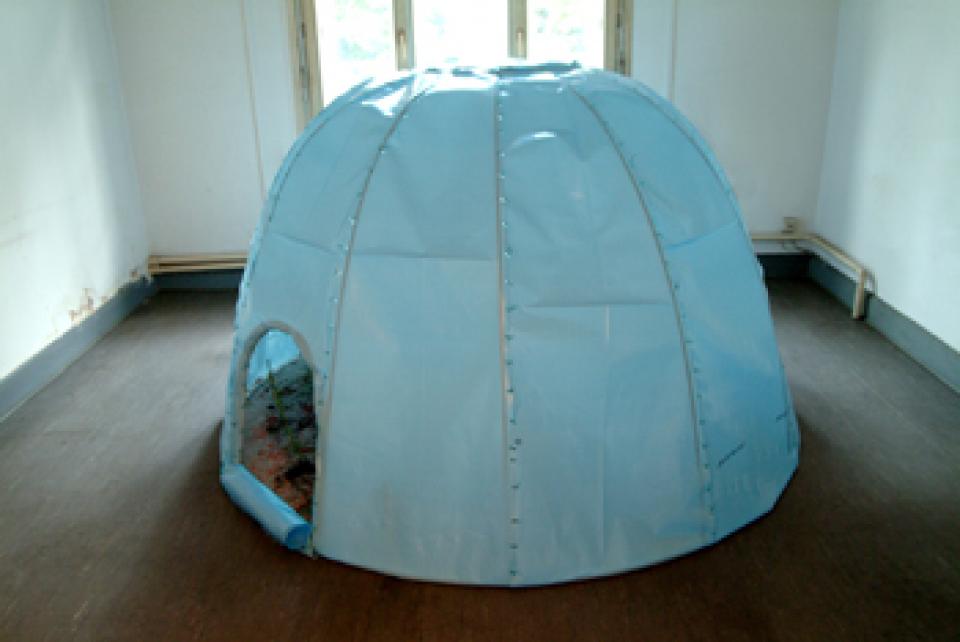
01 // Arbeiten 2006 # 08 Iglu, Baufolien, Holz, Naturmaterial, Pflanzen, 250 x 250 x 150 cm
-
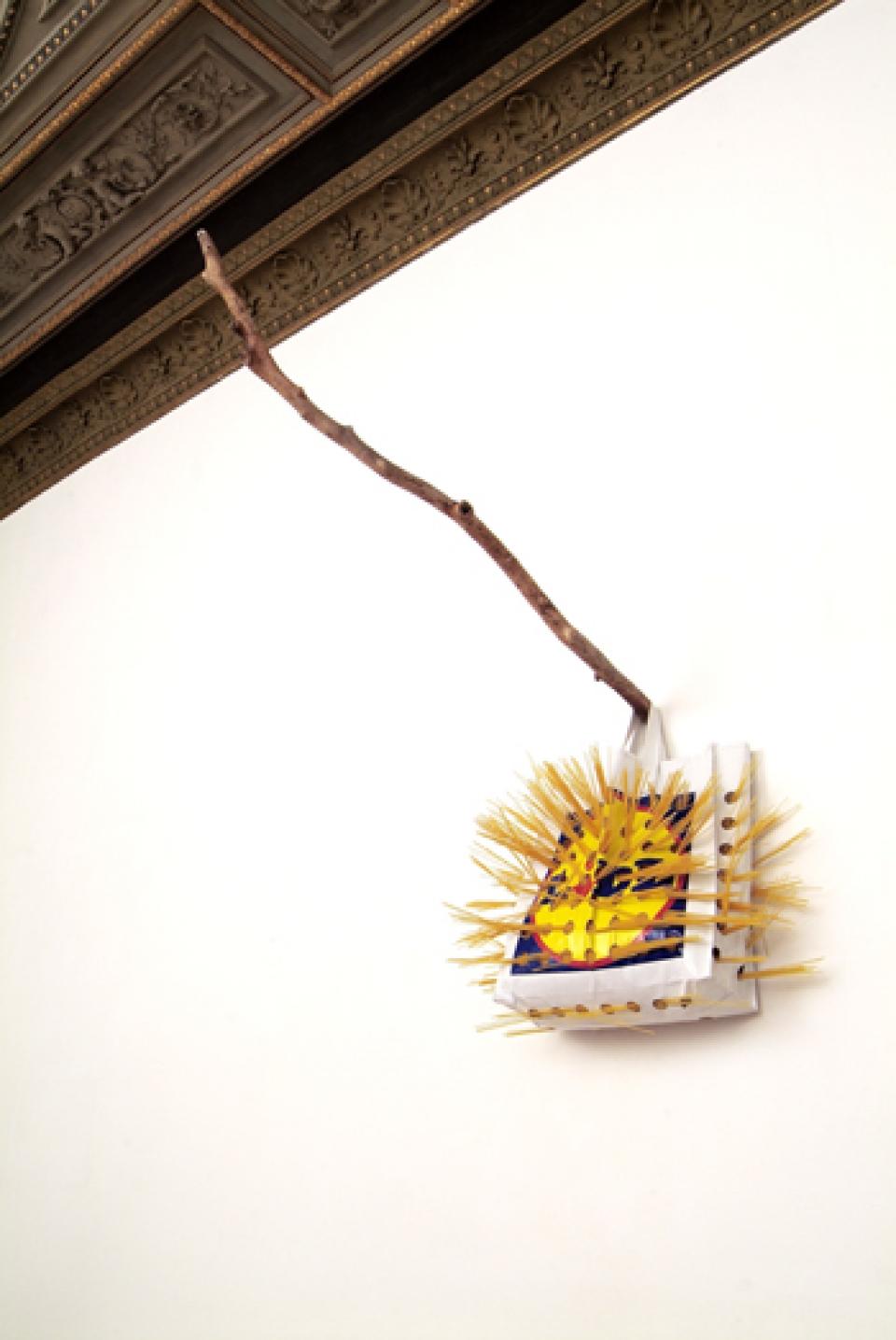
02 // Arbeiten 2007 # 02 Um Himmels Willen
-

02 // Arbeiten 2007 # 02 Kiosk / Heimat 2005/07, PVC-Wellblech, Holz, Fotographie, 50 x 210 x 360 cm
-
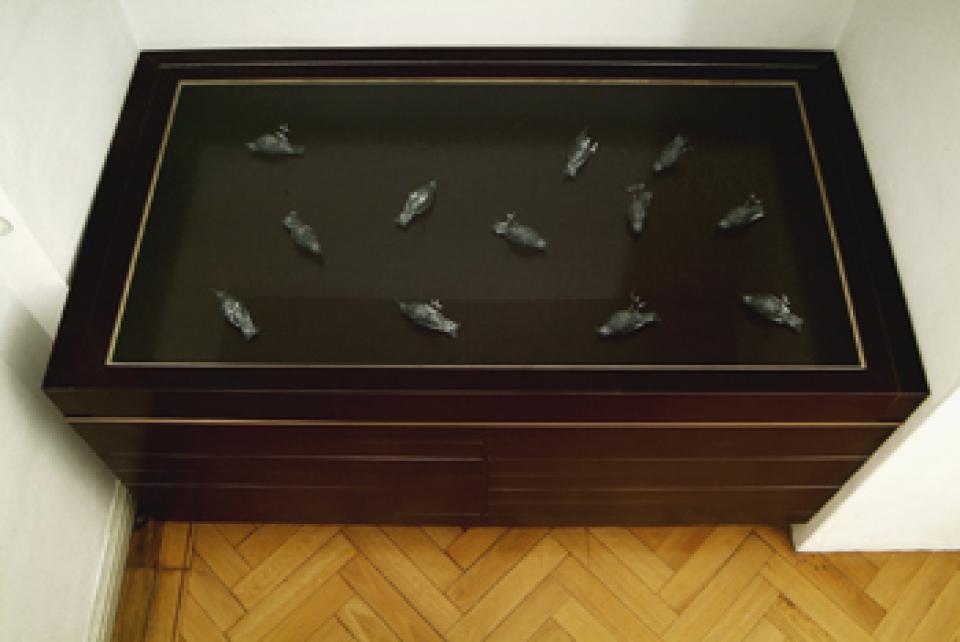
02 // Arbeiten 2007 # 04 Versammlung, Papier, Größe variabel
-

02 // Arbeiten 2007 # 05 Vulkanausbruch, Mixed Media, 200 x 127 x 240 cm
-

02 // Arbeiten 2007 # 07 Ohne Titel, Holzlatten, 88 x 244 x 231 cm
-
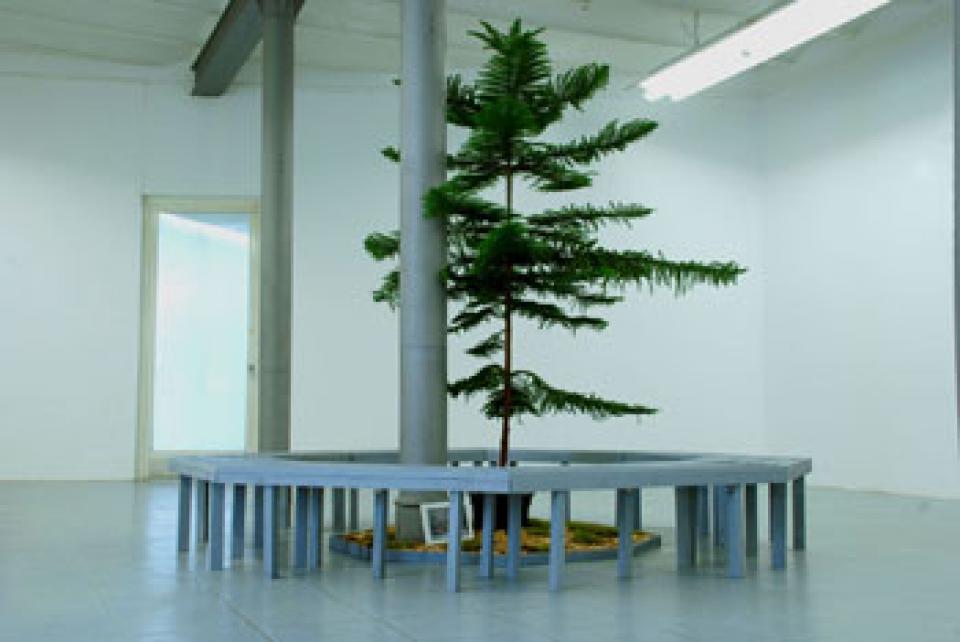
03 // Arbeiten 2008 # 01 Zwei Orte, Holz, Foto, Naturmaterialien, 350 x 350 x 250 cm
-
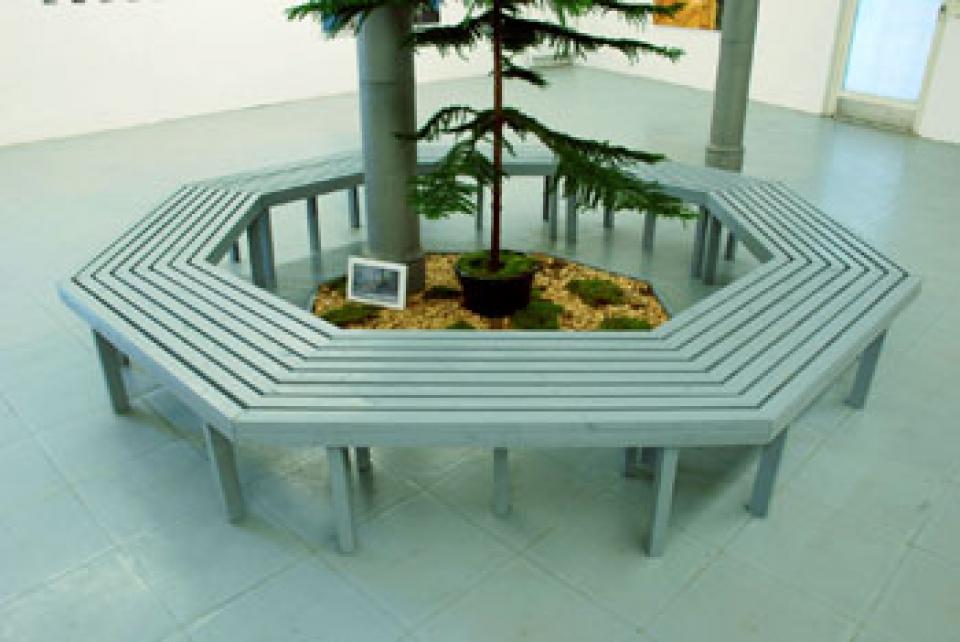
03 // Arbeiten 2008 # 02 Zwei Orte (Detail)
-

03 // Arbeiten 2008 # 04 Kiosk/Modell, PVC-Wellblech, Holz, Digitalbilderrahmen, 50 x 240 x 360 cm
-

03 // Arbeiten 2008 # 06 Kiosk/Modell (Detail)
-

03 // Arbeiten 2008 # 07 Kiosk/Modell (Detail)
-

04 // Arbeiten 2008/09 # 01 Äste, 2008
-

04 // Arbeiten 2008/09 # 02 Äste, 2008
-
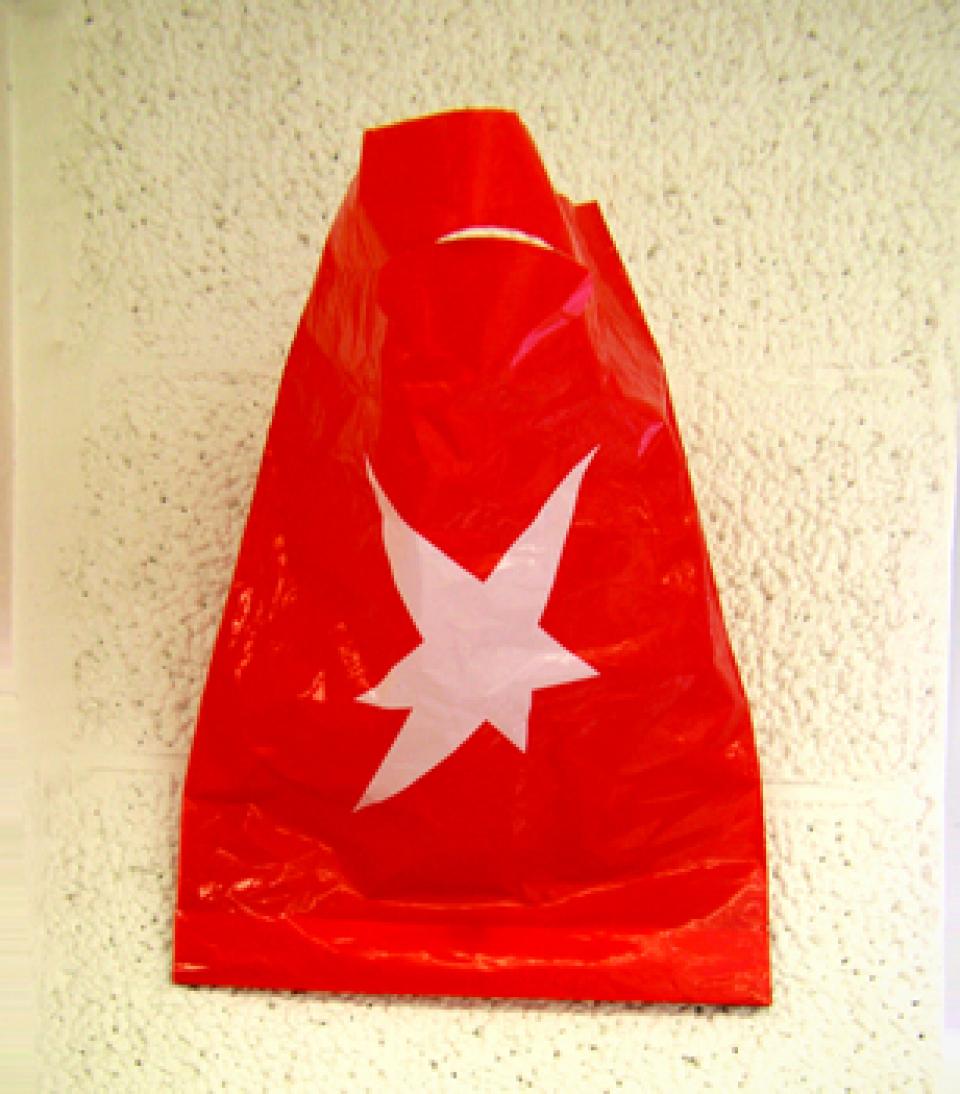
04 // Arbeiten 2008/09 # 03 Stern, 2008
-

04 // Arbeiten 2008/09 # 05 Halle, 2008
-

04 // Arbeiten 2008/09 # 06 Stadion, 2008
-

05 // Arbeiten 2010 # 01 Heute kommt und morgen bleibt , 2010, Wandfarbe, Holz, Stofftasche, Rauminstallation
Ausstelung: Heute kommt und morgen bleibt | 2010
(Städtische Galerie Bremen)
-

05 // Arbeiten 2010 # 02 Heute kommt und morgen bleibt , 2010, Wandfarbe, Holz, Stofftasche, Rauminstallation
Ausstellung: Heute kommt und morgen bleibt | 2010
(Städtische Galerie Bremen) -

05 // Arbeiten 2010 # 03 Sonnenfinsternis , 2010, Holz, Samt, Rauminstallation
-

05 // Arbeiten 2010 # 04 Der kleine Tempel , 2010 , Spanplatte, Laterne, Kerze, Folie, 700 x 250 x 400 cm
-
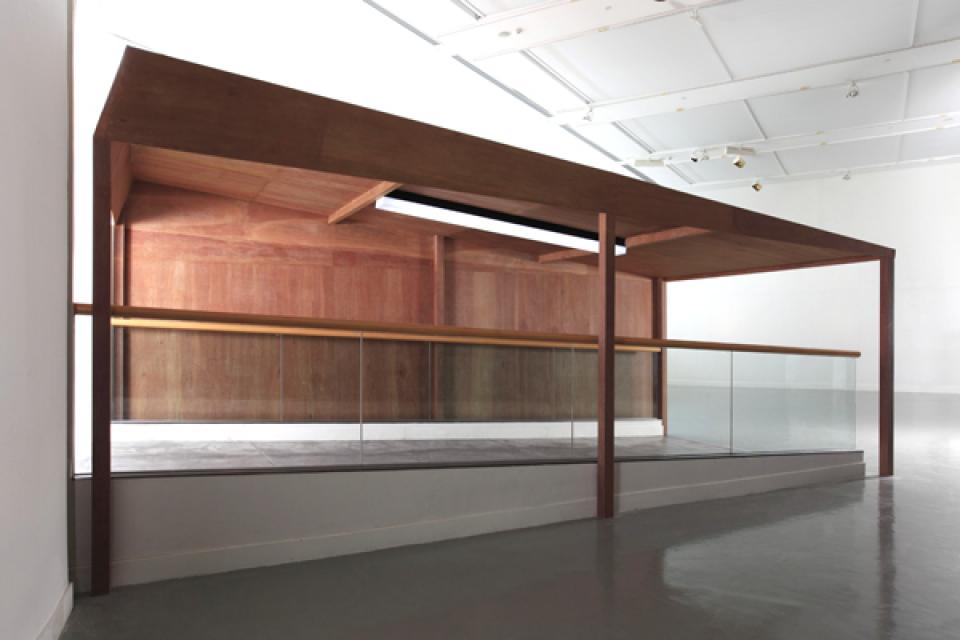
05 // Arbeiten 2010 # 05 Second Class , Second Class, 2010 , Holz, künstliche Beleuchtung, Folie, 365 x 760 x 279 cm
-

06 // Pressetexte # 02 Text (engl.) über Preechaya Siripanichs Arbeiten, 2008
von Yasin Güzel
(Translation: Philipp Albers):
"The works of Thai artist Preechaya Siripanich explore the tensions between nature and culture, man and city, culture and identity, life and death, wish and reality. He unfolds these topics in narrative installations and architectural miniatures. The meaning of space and architecture are often at the fore of his works of art, reflecting the modern ways of living and the basic conditions of our human existence.
For example, on occasion of an exhibition in one of the multistoried parking garages of the company BrePark (2006), the artist engaged with the site. Using packaging materials such as cardboard, he built a model of such a garage. He contrasts the solid and luxurious building with a plain construction of paper. On the paper roof an ironic label states "Please Remove," basically a superfluous instruction to the consumer. Given the context, the sentence devalues a stony "monstrosity" in the city space and - at the same time - ironically attacks the artist's own artistic practice. Worthlessness, transience, and isolation are constant elements of his work. The cityscape and architectural models are devoid of people, as if these places have been left behind, having become useless. Reasons might be a recession or natural disaster, for example. The work Volcanic Eruption hints at this with its title. The playful architectural forms made of cardboard are covered with white dust, cold snow blanketing everything. A city in decay.
Igloo (2006) also visualizes such deserted spaces and loss: inside the tent are sand, stones, and plants. Nature has taken over culture again after the people's departure. At the same time it represents a basic human situation: to shield himself against the forces of nature, man needs a shelter. He tries to tame nature in a cultural enclosure. Here, the beginning and end of culture meet. People come, people go. The tent is also the form of nomadic dwelling.
The work The Tent (2006) opens a view into an improvised abode made of freezer foil with the logo of the supermarket chain Penny, and in it we can see the most basic belongings of a human being. Someone is still living here. The nomad or derelict uses materials from other contexts to secure his existence. The tent is reminiscent of an emergency shelter, made from waste materials by people in impoverished areas. Another more personal experience of the artist also comes into play here. Siripanich emigrated from Thailand to Germany. After having studied art in Thailand, he attended art school again in Bremen to engage with European art and its traditions. Every migrant knows the feelings of uprooting, an inner homelessness. It is an inner floating between two places that prevents settling down permanently. In Kiosk (2005/08), exhibited in the Städtische Galerie Bremen and the Galerie für Gegenwartskunst, the artist also reflects on this experience. A kiosk is a public meeting place for homeless people, and here it is itself a shack that could be set up elsewhere.
The artist conveys the floating between the present life here and life there especially insistently in the work Two Places (2008). It consists of a bench arranged around a column of the Städtische Galerie. Bark mulch lies on the floor around the column, and there is a Douglas fir. The fir stands in a pot - a miniature park, as it were. Beside the pot there is a photograph depicting a Buddhist meditating on a bench also in front of a landscape of firs in Thailand. Those who notice the photograph will realize that they are engaging in an action similar to the Buddhist. Proximity and a personal connection to the other world of the photograph are created. Siripanich enables the viewer to experience for himself the experience to inwardly live at two places. The fir is also a proxy for Christmas and Christianity. Thus, Two Places also reflects a social reality we might designate as transculture.
It means that cultures always relate to one another and intermingle. They are in constant contact with each other. Globalization and migration only intensified this process. In the installation Äst (2008) the packaging of Asian fast food gets caught in a tree. This could happen in many places in today's world, an effect of the worldwide exchange of goods, food, and consumer products.
The work Samui (2008) addresses the yearning for a homeland or, more generally, the yearning for a different, maybe ideal world. Samui is a Thai island. In front of a suitcase, a guitar, and two palms are three tablets on provisional wood stands. The rays on the middle tablet point to the middle, like a star, which is also a symbol for far-off places and for longing. In this context it can be interpreted as a sign for the human search for a place where one can feel secure. Even if just for a short period of recreation. It calls to mind the nomad - and then the traveler and the tourist, who is also on the go for a limited period of time. Samui is also a popular tourist destination.
Visions and wishes in general are important topics for the artist. There hangs a bag, again with a Star (2008), as a ready-made on the wall. It is a product of the magazine Stern. With its rich connotations of signposts, light, glamorous individuality, and fulfillment, this symbol has been conferred on a simple commodity, a news magazine. Should it promise guidance and light? Advertising attaches an external object to the need for happiness. On the wall the star seems to speak for itself again, indicating a closeness to pop art, which deals with advertising quite critically, partly using consumer goods as material.
In the work For Heaven's Sake (2007) the artist also hints at how advertising appropriates symbols and emotions, and how capital defines life. Namely, the holes in the bag are exactly the size of one-euro coins.
Architecture is another arena for embodying visions. Stadium (2008) is a minimalist and playful work of art. Stadiums are stages for extraordinary stories and events; they are the linchpin of urban visions. Identifying with the athletic successes that take place there, the individual gains a sense of grandeur and power. Here again, the artist works against the structure's monumental meaning by employing transient materials such as cardboard and plywood. The model gives the impression of being unfinished, as if still under construction. In a way the public stadium is provisional like the private tent. Two other architectural models, Hall and Bunker (2008), also belong to this minimalist group of works. In contrast to the open and public Stadium they seem to enclose something private and are evocative of coffins. Their function remains enigmatic.
It may be noted here that architecture, because it is also a refuge, is considered as an extension of the body. In Siripanich's works it is also always to be understood as a symbol of the perishable human being and his perishable culture. Memento mori are a constant motif in the sculptures and installations. Gathering (2007) assembles dead birds, starlings, made of paper in a display cabinet as in a coffin. A dreadful, apocalyptic idea. By all means can it be interpreted as a parable of the situation of art. The desire for fame, the want to rise above the circumstances, at which the starling hints, finds its remorseless end in death. Dead is dead. That is where life comes to a head. Thus, in Morning on the Terrace (2007) another dead bird lays in the corner of a triangular balcony. Death looms everywhere, even in the abstract repository of culture. It can rise against nature but cannot transcend this boundary.
Siripanich very clearly investigates the relationship between culture and nature. Encountering dead animals on the street or in the home is not uncommon. They are in part the victims of civilization. The installation Magpie (2007) poetically and buoyantly sheds light on the interrelation between nature and city. A bicycle covered with a blanket thereby receives a skin, a body. In contrast, the magpie as a living animal is formed as a word and introduced as a cultural, abstract existence. At the same time the sequence of letters could be a view of the city from above. Or roadways, on which the bicycle and the bird move. The artist transfigures the machine into nature and translates the animal into culture. The boundaries between the two blur, and they form a whole.
The artist from Thailand explores cultural processes in his own special way. Given his background, he deals with the relationship of Asian and Western culture and in his artistic work fuses forms and ideas from both worlds. He himself has been shaped by Buddhism, which also in part defines the contents of his works and explains his affinity to minimalism. His works emphasize the changes, the transience, and evanescence of life. Advertising as well is just superficial information, which we briefly absorb and then forget. In the end, nothing remains for us personally. We are all travelers and wanderers. Our body is only a provisional packaging for our soul and spirit. Particularly in view of death, our drives and wishes are important, guiding powers for the creation of meaning and identity. Siripanich examines how these powers shape our urban environment. How the concrete acts in the abstract, or how nature acts in culture."
-

06 // Pressetexte # 03 Einzelausstellung in der Galerie für Gegenwartskunst, 2007
Rede zur Ausstellungseröffnung in der Galerie für Gegenwartskunst, Bremen
Barbara Claassen-Schmal, Galeristin:
"Dies ist die erste Einzelausstellung des thailändischen Künstlers Preechaya Siripanich.
Er hat die Galerieräume für einige Wochen als Atelier genutzt. Die verschiedener Installationen sind fast alle vor Ort entstanden.
Bisher konnte man Preechaya Siripanich an der Hochschule für Künste treffen, wo er 2006 sein Studium als Meisterschüler von Yuji Takeoka abschloss hat.
Dort entstanden die Table aus utopischer Mega-Städte, für die der Künstler farbige Verpackungskartons konstruktiv verändert und mit Öffnungen versehen hatte. Scheinbar funktionale Gebäude, wie Tankstellen, Silos und Fabriken bildeten raumgreifende Ensemble.
Diese Territorien waren keine Lebensräume für Menschen, sondern eher Produktions- und Wirtschaftsräume, die eine gewisse Heiterkeit ausstrahlten, weil sie, an Warhol verweisend, all die bunten Warenlabels trugen, die Konsumenten zum Kauf anreizen.
Diese Installationen leerer Gehäuse erinnerten an urbane Regionen, die ihre Funktion verloren zu haben schienen, oder vielleicht nie wirkliche Funktionen hatten.
Die modellhafte Maßstäblichkeit dieser topografischen Ensembles verlor sich, wenn sich aus Kelloggs Packungen tatsächlich Haferflocken ergossen oder aus anderen Verpackung Würfelzucker herausrutschte.
Die Stadt-Utopie in der Ausstellung treibt dieses Vexierspiel noch weiter. Wie nach einem Vulkanausbruch oder einer plötzlichen Schneekatastrophe ist alles von weißem Pulver bedeckt. Die Unberührtheit der Szene assoziiert die Vorstellung eines gedehnten Moments, die Zeit scheint still zu stehen. Und doch scheint sich dieser Zustand nicht unbegrenzt in die Zukunft zu verlängern.
Alles befindet sich in einem offenen, latenten Stadium, nichts ist so wie es scheint, das Sichtbare ist nicht zwangsläufig das Wahre. Die übergrosse Laterne irritiert mehr, als dass sie die Situation erleuchtet und sobald ein Sturm über die Stadt fegt, könnte sich wieder alles verändern.
Der Kiosk in dieser Ausstellung hat sein Erscheinungsbild gewandelt, er war schon einmal wie ein tatsächlicher Laden mit Regalen und Waren ausgestattet. Von all dem entkleidet, reduziert auf die architektonische Form, findet der Betrachter in dem Gebäude nur noch eine Fotografie vor. Es zeigt eine kleine Tempelanlage vor der ein buddhistischer Mönch sitzt. Diese Fotografie ist der einzige Verweis auf Thailand, die Heimat des Künstlers. Diese Abbildung ist quasi der Ausgangspunkt der Ausstellung.
Die Fotografie entstand 2003 als Preechaya Siripanich für 6 Wochen in Thailand in ein Kloster gegangen war. Wenn er heute davon spricht, dann überwiegt in seiner Erinnerung das Fremdsein in dieser Situation: der Tagesablauf war ungewohnt, die Füße schmerzten vom Bahrfußlaufen, das Betteln um Nahrung war fremd, auf eigenes Geld musste er verzichten, die buddhistische Bethaltung war ungewohnt usw. Diese Erlebnisse beschreiben die Distanz, die inzwischen zu seiner Heimat entstanden war.
Künstler wie Preechaya Siripanich sind damit konfrontiert, die fremde Kultur neuer Lebensräume aufzunehmen und in den Dialog mit der eigenen Tradition stellen zu müssen.
Der einhergehende Verlust von kultureller Identität schafft, man könnte sagen, ÄZwischenräume“ in denen sich verschiedene Einflusssphären zu überlagern und zu vermischen beginnen. Der Kiosk von Preechaya Siripanich ist ein Beispiel dafür.
In solchen Zwischenzonen, den ehemals getrennten lebensweltlichen Territorien, entstehen neben Vermischungen und Überlagerungen auch Rekombinationen und Zonen der Undeutlichkeit, Salman Rushdie hat in diesem Zusammenhang den Begriff der ÄBastarisierung“ geprägt.
Die gesteigerte Aufmerksamkeit für kulturelle Transfers dieser Art sind Erscheinungsformen der Globalisierung, die schon längst die zeitgenössische Kunst erreicht haben. Die Ergebnisse kultureller Vermischungen muss man sich aber nicht unbedingt als friedliche multikulturelle Koexistenz von ehemals Fremdem vorstellen. Entscheidend sind vielmehr die Unübersetzbarkeiten auch die des Humors, die sich in jeder Kultur finden und die letztendlich widerständig bleiben und Ausstellung wie diese so interessant machen." -

06 // Pressetexte # 04 Protokolle des Absurden, 2007
Rainer B. Schossig, Kulturjournalist:
"Von wegen Multikulti! Der nigerianische Ausstellungsmacher Okwui Enwesor hat dem Rest der Welt mit seiner Ä Documenta 11" klargemacht, dass auch der ästhetische Zusammenprall der Kulturen nicht nur heiter und schmerzlos, sondern ernst und voller Tristesse sein kann. Seither treten mehr und mehr hybride Künstler-Existenzen in unser eurozentrisch geprägtes Blickfeld. In ihrer Bremer ÄGalerie für Gegenwartskunst" stellt Barbara Claassen-Schmal jetzt Preechaya Siripanich vor, einen Thailänder, der seit 2000 in Europa lebt und in Bremen bei Yuji Takeoka Bildhauerei studiert hat.
Migranten- Stimmung im Altbremer Haus: an einem Knotenstock an der Wand eine Lidl-Plastiktüte mit eurogroßen Löchern, aus denen jede Menge Spaghetti ragen; davor eine Art Laufstall mit bunten Häuschen aus Pappkartons, alle mit weißem Kalk verschneit, beleuchtet von einer Riesen-Straßenlaterne aus Abflussrohr mit Kellerleuchte. Weiter: ein leerer Kiosk aus Wellblech und Sperrholz, in dem nur ein Foto des Künstlers ausgestellt wird, das ihn meditierend in einem buddhistischen Kloster zeigt, gegenüber ein glitzernder, dreieckiger Alu-Balkon, auf dem ein toter Star aus Papier liegt. Preechaya Siripanich, geboren 1973 im thailändischen Saraburi, hat auch schon Iglus aus zeltplanen für Brackwasser-Biotope gebaut oder eine winterfeste Unterkunft aus Thermotüten für Stadtstreicher.
Sind dies Alltags-Repliken oder utopische Modelle, Projekte oder Protokolle des Absurden, Spielzeug oder Allegorie?
Durchgängig geht es um Heimat und Zuflucht, Behausung und Fremde. Preechaya Siripanichs Installationen aus Wertstoff- und Sperrmüll-Funden, aus exakt verarbeiteten baumarkt- Halbfertigprodukten oder Verpackungsmaterialien siedeln programmatisch in den Hohl- und Zwischenräumen, den Un- Orten den blinden Flecken und Fehlstellen der globalen Zivilisation. Seine Kreativität lebt von unseren Missverständnissen über das angeblich Ä Exotische" des fern Ostens.
Was wir fremd findet, ist dem Gast aus Thailand geläufig, und ihm wird zum Gleichnis, was uns ob seiner ÄNormalität" schon gar nicht mehr auffällt: Etwas wenn er eine schwarze Motorrad- Hülle, der er ein weißes Feld aufgemalt hat, über ein Fahrrad stülpt. Fertig ist eine faltenschwere, melancholische Skulptur; Titel Ä Elster". Daneben liegen ein Dutzend tote Papierstare in der Vitrine. Man verlässt gedankenvoll- poetisch gestimmt das Haus. Von wegen Multikulti..." -
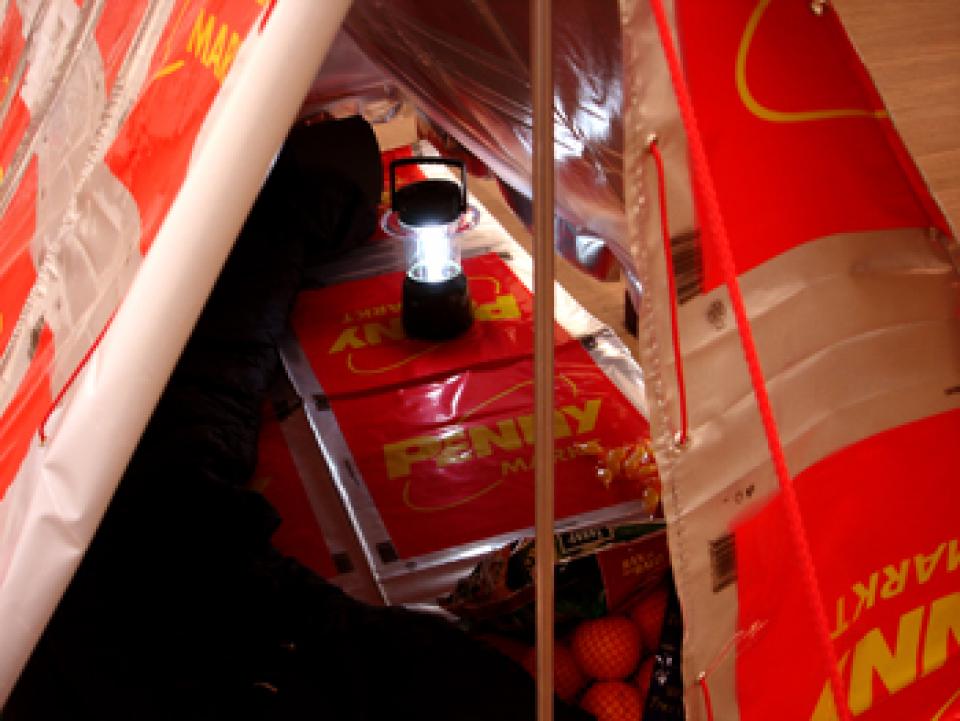
06 // Pressetexte # 05 Text über die Arbeit "Das Zelt", 2008
Stefanie Böttcher, Kuratorin, Bremen:
"Die Werke von Preechaya Siripanich sind Fremdkörper in einer vertrauten Welt. Uns bekannte Gegenstände, Materialien, Bilder fasst der thailändische Künstler zu bizarren Konstellationen zusammen, ordnet sie in neue Zusammenhänge ein. Neben dem visuellen Eindruck senden seine Arbeiten aber auch olfaktorische Reize aus. So besteht Zelt (2006/08) aus Gefriertüten mit dem strahlenden, weithin sichtbaren Penny-Schriftzug, die sich zu einem Reisezelt zusammen fügen. Diese temporäre Behausung, die auch für ein nomadenhaftes Dasein steht, befindet sich inmitten eines geweißten Areals mit zahlreichen Schuhabdrücken. Der Duft, den das Material verströmt, enttarnt es als Waschpulver. So werden wir zwar gewahr, dass es sich nicht um Schnee handelt, zugleich entfaltet sich aber eine Atmosphäre, die eben jener in einer verschneiten Landschaft ähnelt: Frische und Kühle erfüllen den Raum. Im Zelt finden wir wenige Hinterlassenschaften, ein privater Raum, der doch so wenig Persönliches birgt. Ein Ort, dessen Künstlichkeit Fremdartigkeit signalisiert, den Zusammenprall diverser kultureller Güter, der letztlich auch für Entwurzeltsein und Isolierung steht."